1
6
C Arrays
2007 Pearson Education, Inc. All rights reserved.
2
OBJECTIVES
In this chapter you will learn: To use the array data structure to represent lists
and tables of values.
To define an array, initialize an array and refer to
individual elements of an array.
To define symbolic constants. To pass arrays to functions. To use arrays to store, sort and search lists and
tables of values.
To define and manipulate multiple-subscripted
arrays.
2007 Pearson Education, Inc. All rights reserved.
3
6.1
Introduction
6.2 Arrays
6.3 Defining Arrays
6.4 Array Examples
6.5 Passing Arrays to Functions
6.6 Sorting Arrays
6.7 Case Study: Computing Mean, Median and Mode
Using Arrays
6.8 Searching Arrays
6.9 Multiple-Subscripted Arrays
2007 Pearson Education, Inc. All rights reserved.
4
6.1 Introduction
Arrays
– Structures of related data items – Static entity – same size throughout program – Dynamic data structures discussed in Chapter 12
2007 Pearson Education, Inc. All rights reserved.
5
6.2 Arrays
Array
– Group of consecutive memory locations – Same name and type
To refer to an element, specify
– Array name – Position number
Format:
arrayname[ position number ]
– First element at position 0 – n element array named c:
- c[ 0 ], c[ 1 ]...c[ n – 1 ]
2007 Pearson Education, Inc. All rights reserved.
6
Fig. 6.1 | 12-element array.
2007 Pearson Education, Inc. All rights reserved.
7
6.2 Arrays
Array elements are like normal variables
c[ 0 ] = 3; printf( "%d", c[ 0 ] );
– Perform operations in subscript. If x equals 3
c[ 5 - 2 ] == c[ 3 ] == c[ x ]
2007 Pearson Education, Inc. All rights reserved.
8
Fig. 6.2 | Operator precedence.
2007 Pearson Education, Inc. All rights reserved.
9
6.3 Defining Arrays
When defining arrays, specify
– Name – Type of array – Number of elements
arrayType arrayName[ numberOfElements ];
– Examples:
int c[ 10 ];
float myArray[ 3284 ];
Defining multiple arrays of same type – Format similar to regular variables – Example:
int b[ 100 ], x[ 27 ];
2007 Pearson Education, Inc. All rights reserved.
10
6.4 Array Examples
Initializers
int n[ 5 ] = { 1, 2, 3, 4, 5 };
– If not enough initializers, rightmost elements become 0
int n[ 5 ] = { 0 }
- All elements 0
– If too many initializers, a syntax error occurs – C arrays have no bounds checking
If size omitted, initializers determine it int n[ ] = { 1, 2, 3, 4, 5 }; – 5 initializers, therefore 5 element array
2007 Pearson Education, Inc. All rights reserved.
Outline
fig06_03.c
(1 of 2 )
11
for loop initializes each array
element separately
for loop outputs all array elements
2007 Pearson Education, Inc. All rights reserved.
Outline
fig06_03.c
(2 of 2 )
12
2007 Pearson Education, Inc. All rights reserved.
Outline
fig06_04.c
(1 of 2 )
initializer list initializes all array elements simultaneously
13
2007 Pearson Education, Inc. All rights reserved.
Outline
fig06_04.c
(2 of 2 )
14
2007 Pearson Education, Inc. All rights reserved.
Outline
15
#define directive tells compiler to replace all
instances of the word SIZE with 10
fig06_05.c
(1 of 2 )
SIZE is replaced with 10 by the
compiler, so array s has 10 elements
for loop initializes each array
element separately
2007 Pearson Education, Inc. All rights reserved.
Outline
fig06_05.c
(2 of 2 )
16
2007 Pearson Education, Inc. All rights reserved.
• Compute the elements of the arrays
Outline
fig06_06.c
initializer list initializes all array elements simultaneously
18
for loop adds each element of the
array to variable total
2007 Pearson Education, Inc. All rights reserved.
• Student poll program
Outline
20
#define directives create
symbolic constants
fig06_07.c
(1 of 2 )
frequency array is
defined with 11 elements
responses array is defined with 40 elements and its elements are initialized
subscript of frequency array is given
by value in responses array
2007 Pearson Education, Inc. All rights reserved.
Outline
fig06_07.c
(2 of 2 )
21
2007 Pearson Education, Inc. All rights reserved.
• Histogram printing program
Outline
fig06_08.c
(1 of 2 )
nested for loop prints n[ i ] asterisks on the ith line
23
2007 Pearson Education, Inc. All rights reserved.
Outline
fig06_08.c
(2 of 2 )
24
2007 Pearson Education, Inc. All rights reserved.
• Roll a six-sided die 6000 times
Outline
fig06_09.c
(1 of 2 )
26
for loop uses one array to track
number of times each number is rolled instead of using 6 variables and a switch statement
2007 Pearson Education, Inc. All rights reserved.
Outline
fig06_09.c
(2 of 2 )
27
2007 Pearson Education, Inc. All rights reserved.
28
6.4 Array Examples
Character arrays
– String “first” is really a static array of characters – Character arrays can be initialized using string literals
char string1[] = "first"; - Null character '\0' terminates strings - string1 actually has 6 elements
It is equivalent to
char string1[] = { 'f', 'i', 'r', 's', 't', '\0' }; – Can access individual characters string1[ 3 ] is character „s‟
– Array name is address of array, so & not needed for scanf
scanf( "%s", string2 );
- Reads characters until whitespace encountered - Be careful not to write past end of array, as it is possible to do so
2007 Pearson Education, Inc. All rights reserved.
Outline
fig06_10.c
(1 of 2 )
29
string2 array is defined with one element for each character, so 15 elements including null character /0
for loop prints characters of string1
array with spaces in between
2007 Pearson Education, Inc. All rights reserved.
Outline
fig06_10.c
(2 of 2 )
30
2007 Pearson Education, Inc. All rights reserved.
Outline
fig06_11.c
(1 of 4 )
31
2007 Pearson Education, Inc. All rights reserved.
Outline
fig06_11.c
32
static array is created only once, when staticArrayInit is first called
(2 of 4 )
2007 Pearson Education, Inc. All rights reserved.
Outline
fig06_11.c
33
automatic array is recreated every time automaticArrayInit is called
(3 of 4 )
2007 Pearson Education, Inc. All rights reserved.
Outline
fig06_11.c
(4 of 4 )
34
2007 Pearson Education, Inc. All rights reserved.
35
6.5 Passing Arrays to Functions
Passing arrays
– To pass an array argument to a function, specify the name of the
array without any brackets
int myArray[ 24 ]; myFunction( myArray, 24 ); - Array size usually passed to function
– Arrays passed call-by-reference – Name of array is address of first element – Function knows where the array is stored - Modifies original memory locations
Passing array elements – Passed by call-by-value – Pass subscripted name (i.e., myArray[ 3 ]) to function
2007 Pearson Education, Inc. All rights reserved.
36
6.5 Passing Arrays to Functions
Function prototype
void modifyArray( int b[], int arraySize );
– Parameter names optional in prototype - int b[] could be written int [] - int arraySize could be simply int
2007 Pearson Education, Inc. All rights reserved.
Outline
fig06_12.c
37
2007 Pearson Education, Inc. All rights reserved.
Outline
fig06_13.c
Function prototype indicates function will take an array
(1 of 3 )
Array a is passed to modifyArray
by passing only its name
38
2007 Pearson Education, Inc. All rights reserved.
Outline
fig06_13.c
(2 of 3 )
Array element is passed to modifyElement
by passing a[ 3 ]
39
2007 Pearson Education, Inc. All rights reserved.
Outline
fig06_13.c
(3 of 3 )
40
2007 Pearson Education, Inc. All rights reserved.
Outline
fig06_14.c
(1 of 2 )
41
const qualifier tells compiler that
array cannot be changed
Any attempts to modify the array will
result in errors
2007 Pearson Education, Inc. All rights reserved.
Outline
fig06_14.c
(2 of 2 )
42
2007 Pearson Education, Inc. All rights reserved.
43
6.6 Sorting Arrays
Sorting data
– Important computing application – Virtually every organization must sort some data
Bubble sort (sinking sort)
– Several passes through the array – Successive pairs of elements are compared If increasing order (or identical ), no change If decreasing order, elements exchanged
- - – Repeat
Example:
– original: 3 4 2 6 7 – pass 1: 3 2 4 6 7 – pass 2: 2 3 4 6 7 – Small elements "bubble" to the top
2007 Pearson Education, Inc. All rights reserved.
Outline
fig06_15.c
(1 of 2 )
44
2007 Pearson Education, Inc. All rights reserved.
Outline
If any two array elements are out of order, the function swaps them
fig06_15.c
(2 of 2 )
45
2007 Pearson Education, Inc. All rights reserved.
46
6.7 Case Study: Computing Mean, Median and Mode Using Arrays
Mean – average Median – number in middle of sorted list
– 1, 2, 3, 4, 5 – 3 is the median
Mode – number that occurs most often
– 1, 1, 1, 2, 3, 3, 4, 5 – 1 is the mode
2007 Pearson Education, Inc. All rights reserved.
Outline
fig06_16.c
(1 of 6 )
47
2007 Pearson Education, Inc. All rights reserved.
Outline
fig06_16.c
(2 of 6 )
48
2007 Pearson Education, Inc. All rights reserved.
Outline
fig06_16.c
(3 of 6 )
Once the array is sorted, the median will be
the value of the middle element
49
2007 Pearson Education, Inc. All rights reserved.
Outline
fig06_16.c
(4 of 6 )
50
2007 Pearson Education, Inc. All rights reserved.
Outline
fig06_16.c
(5 of 6 )
51
2007 Pearson Education, Inc. All rights reserved.
Outline
fig06_16.c
(6 of 6 )
52
2007 Pearson Education, Inc. All rights reserved.
Outline
(1 of 2 )
53
2007 Pearson Education, Inc. All rights reserved.
Outline
(2 of 2 )
54
2007 Pearson Education, Inc. All rights reserved.
55
6.8 Searching Arrays
Search an array for a key value Linear search – Simple – Compare each element of array with key value – Useful for small and unsorted arrays
2007 Pearson Education, Inc. All rights reserved.
Outline
fig06_18.c
(1 of 3 )
56
2007 Pearson Education, Inc. All rights reserved.
Outline
fig06_18.c
(2 of 3 )
57
2007 Pearson Education, Inc. All rights reserved.
Outline
fig06_18.c
(3 of 3 )
Linear search algorithm searches through every element in the array until a match is found
58
2007 Pearson Education, Inc. All rights reserved.
59
6.8 Searching Arrays
Binary search
– For sorted arrays only – Compares middle element with key
- If equal, match found - If key < middle, looks in first half of array - If key > middle, looks in last half - Repeat
– Very fast; at most n steps, where 2n > number of elements
- 30 element array takes at most 5 steps
25 > 30 so at most 5 steps
2007 Pearson Education, Inc. All rights reserved.
Outline
fig06_19.c
(1 of 6 )
60
2007 Pearson Education, Inc. All rights reserved.
Outline
fig06_19.c
(2 of 6 )
61
2007 Pearson Education, Inc. All rights reserved.
Outline
If value is found, return its index
fig06_19.c
(3 of 6 )
If value is too high, search the left half of array
If value is too low, search the right half of array
62
2007 Pearson Education, Inc. All rights reserved.
Outline
fig06_19.c
(4 of 6 )
63
2007 Pearson Education, Inc. All rights reserved.
Outline
fig06_19.c
(5 of 6 )
64
2007 Pearson Education, Inc. All rights reserved.
Outline
fig06_19.c
(6 of 6 )
65
2007 Pearson Education, Inc. All rights reserved.
66
6.9 Multiple-Subscripted Arrays
Multiple subscripted arrays
– Tables with rows and columns (m by n array) – Like matrices: specify row, then column
Initialization
– int b[ 2 ][ 2 ] = { { 1, 2 }, { 3, 4 } }; – Initializers grouped by row in braces – If not enough, unspecified elements set to zero
int b[ 2 ][ 2 ] = { { 1 }, { 3, 4 } };
Referencing elements
– Specify row, then column
printf( "%d", b[ 0 ][ 1 ] );
2007 Pearson Education, Inc. All rights reserved.
67
Fig. 6.20 | Double-subscripted array with three rows and four columns.
2007 Pearson Education, Inc. All rights reserved.
Outline
fig06_21.c
(1 of 2 )
68
array1 is initialized with both rows full
array2 and array3 are initialized only partially
2007 Pearson Education, Inc. All rights reserved.
Outline
fig06_21.c
(2 of 2 )
69
2007 Pearson Education, Inc. All rights reserved.
Outline
fig06_22.c
(1 of 6 )
Each row in the array corresponds to a
single student’s set of grades
70
2007 Pearson Education, Inc. All rights reserved.
Outline
fig06_22.c
(2 of 6 )
71
average function is passed a row of the array
2007 Pearson Education, Inc. All rights reserved.
Outline
fig06_22.c
(3 of 6 )
72
2007 Pearson Education, Inc. All rights reserved.
Outline
fig06_22.c
(4 of 6 )
73
2007 Pearson Education, Inc. All rights reserved.
Outline
fig06_22.c
(5 of 6 )
74
2007 Pearson Education, Inc. All rights reserved.
Outline
fig06_22.c
(6 of 6 )
75
2007 Pearson Education, Inc. All rights reserved.


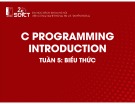
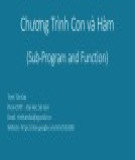
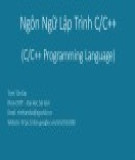
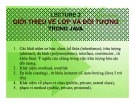
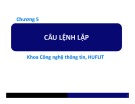
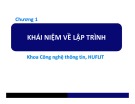
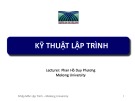
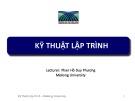
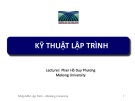

![Câu hỏi trắc nghiệm Lập trình C [mới nhất]](https://cdn.tailieu.vn/images/document/thumbnail/2025/20251012/quangle7706@gmail.com/135x160/91191760326106.jpg)













